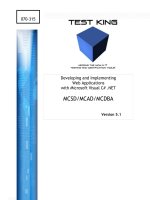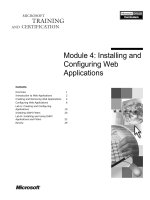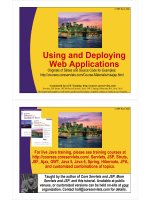Using and Deploying Web Applications
Bạn đang xem bản rút gọn của tài liệu. Xem và tải ngay bản đầy đủ của tài liệu tại đây (3.14 MB, 18 trang )
© 2009 Marty Hall
Using and Deploying
Using
and
Deploying
Web A
pp
lications
pp
Ori
g
inals of Slides and Source Code for Examples:
/>Customized Java EE Training: />Servlets, JSP, Struts, JSF/MyFaces/Facelets, Ajax, GWT, Spring, Hibernate/JPA, Java 5 & 6.
Developed and taught by well-known author and developer. At public venues or onsite at your location.
© 2009 Marty Hall
For live Java training, please see training courses at
http //co rses coreser lets com/ Ser lets JSP Str ts
http
:
//co
u
rses
.
coreser
v
lets
.
com/
.
Ser
v
lets
,
JSP
,
Str
u
ts
,
JSF, Ajax, GWT, Java 5, Java 6, Spring, Hibernate, JPA,
and customized combinations of to
p
ics.
p
Taught by the author of Core Servlets and JSP, More
Servlets and JSP
and this tutorial Available at public
Customized Java EE Training: />Servlets, JSP, Struts, JSF/MyFaces/Facelets, Ajax, GWT, Spring, Hibernate/JPA, Java 5 & 6.
Developed and taught by well-known author and developer. At public venues or onsite at your location.
Servlets
and
JSP
,
and
this
tutorial
.
Available
at
public
venues, or customized versions can be held on-site at your
organization. Contact for details.
Agenda
• Purpose of Web applications
• Structure of Web applications
• Setting up Web applications with Tomcat
• Sharing data among Web applications
4
Idea of Web Applications
• Single directory or file
– Servlets, JSP pages, HTML files, utility classes, beans,
tag libraries, etc. are bundled together in a single
directory hierarchy or file
directory
hierarchy
or
file
• Common URL prefix
– Access to content in the Web a
pp
is alwa
y
s throu
g
h a
pp y g
URL that has a common prefix
– http://host/webAppPrefix/blah/blah
eb ml controls man things
• w
eb
.x
ml
controls
man
y
things
– Many aspects of Web application behavior controlled
through
deployment descriptor
(web.xml)
5
through
deployment
descriptor
(web.xml)
• The deployment descriptor is covered in detail in the next
section.
Purposes of Web Applications
• Organization
– Related files grouped together in a single file or directory
hierarchy.
• HTML files, JSP
p
a
g
es, servlets, beans, ima
g
es, etc.
pg g
• Portability
– All compliant servers support Web apps.
Cdl b i
il
fil
–
C
an re
d
ep
l
oy on new server
b
y mov
i
ng a
si
ng
l
e
fil
e.
• Separation
–
Each Web app has its own:
–
Each
Web
app
has
its
own:
• ServletContext
• Class loader
•
Sessions
6
•
Sessions
• URL prefix
• Directory structure
Structure of a Web Application
• JSP and regular Web content
(HTML style sheets images etc ):
(HTML
,
style
sheets
,
images
,
etc
.
):
– Main directory or a subdirectory thereof.
• Servlets:
WEB
INF/classes (if servlet is unpackaged
i e in default package)
–
WEB
-
INF/classes
(if
servlet
is
unpackaged
–
i
.
e
.
in
default
package)
– A subdirectory thereof that matches the package name.
• Unjarred beans and utility classes:
Same place as servlets (but
always
use packages!)
–
Same
place
as
servlets
(but
always
use
packages!)
• JAR files:
– WEB-INF/lib.
•
web xml:
•
web
.
xml:
– WEB-INF
• Tag Library Descriptor files:
WEB
INF bdi t th f
7
–
WEB
-
INF
or su
bdi
rec
t
or
y
th
ereo
f
• Files in WEB-INF not directly accessible to clients
– Server can use RequestDispatcher to forward to pages in WEB-INF
Example Deployment Structure
8
Installing Eclipse
• Overview
Eli i f
dl i
–
E
c
li
pse
i
s a
f
ree open-source
d
eve
l
opment env
i
ronment
with support for Java and many other languages
• Downloadin
g
g
– />• Choose "Eclipse IDE for Java EE Developers"
•
As of 8/2008, version 3.4, called Eclipse Ganymede
As
of
8/2008,
version
3.4,
called
Eclipse
Ganymede
• Installing
– Unzip into directory of your choice
Ph li dk
–
P
ut s
h
ortcut to ec
li
pse.exe on your
d
es
k
top
• Integrating Tomcat in Eclipse
–
http://www coreservlets com/
9
http://www
.
coreservlets
.
com/
Apache-Tomcat-Tutorial/eclipse.html
Configuring Eclipse
• Make sure Eclipse
kbT
k
nows a
b
out
T
omcat
– Click on Servers tab at bottom.
R
-
click in window
R
-
click
in
window
.
– New, Server, Apache, Tomcat v6.0,
Next, navigate to folder, Finish.
• Suppress unnecessary
compiler warnings
Wi d
Pf
–
Wi
n
d
ow
P
re
f
erences
Java Compiler
Errors/Warnin
g
s
10
g
• Change "Serializable class
without " to "Ignore"
Making Web Apps in Eclipse
• Make empty project
– File
N
ew Project
Web Dynamic Web Project
–
Giveitaname(eg
"
test
"
)
–
Give
it
a
name
(e
.
g
.,
test )
– Accept all other defaults
• Shortcut
– If you have made Dynamic
Web Project recently in
workspace you can just do
workspace
,
you
can
just
do
File New
Dynamic Web Project
11
Adding Code to Eclipse Projects
• Locations
src
–
src
• Unpackaged Java code
• Packages strongly recommended
–
src/somePackage
src/somePackage
• Java code in somePackage package
– WebContent
• Web files
(
HTML, JavaScri
p
t,
(p
CSS, JSP, images, etc.)
– WebContent/some-subdirectory
• Web content in subdirectory
W bC t t/WEB
INF
–
W
e
bC
on
t
en
t/WEB
-
INF
• web.xml (will be discussed later)
• Can also click on
"De
p
lo
y
ment Descri
p
tor"
12
py p
• Note
– Can cut/paste or drag/drop files into appropriate locations
Starting Server in Eclipse
• Start Tomcat
– Select "Servers" tab at bottom
– R-click on Tomcat
Choose "Start"
–
Choose
"Start"
• Verify server startup
–
Open browser
Open
browser
– Enter http://localhost/
• You should see blank directory listing
–
If you want pretty Tomcat
welcome page, search for a
folder called ROOT in your
Ecli
p
se works
p
ace.
13
pp
Copy files from
C:\tomcat-dir\webapps\ROOT
to that folder
Deploying App in Eclipse
• Deploy project
– Select "Servers" tab at bottom
– R-click on Tomcat
Choose "Add and Remove Projects"
–
Choose
"Add
and
Remove
Projects"
– Choose project
– Press Ad
d
– Click "Finish"
• Restart
Server
– R-click Tomcat
at bottom
14
at
bottom
– Restart
Testing Deployed Apps in Eclipse
• Start a browser
Eclipse also has builtin browser
–
Eclipse
also
has
builtin
browser
,
but I prefer to use Firefox or
Internet Explorer
•
Test base URL
Test
base
URL
– http://localhost/test/
• Test Web content
http://localhost/test/Hello html
–
http://localhost/test/Hello
.
html
(case sensitive!)
– http://localhost/test/Hello.jsp
–
If
you
used
subd
ir
ecto
ri
es
you used subd ecto es
• http://localhost/test/
some-subdirectory/blah.html
• Test servlets
15
–
http://localhost/test/servlet/HelloServlet
– http://localhost/test/servlet/coreservlets.HelloServlet2
• Note: custom URLs discussed in next section
Eclipse Structure (IDE-specific) vs.
Deployment Structure (Standard)
Deployment
Structure
(Standard)
Eclipse Deployed
Jd
• Java code
–
src/subDirMatchingPackage
•
J
ava co
d
e
– deployDir/webAppName/
WEB-INF/classes/
src/subDirMatchingPackage
• HTML, JSP, Images
– WebContent
WbC / d Di
subDirMatchin
g
Packa
g
e
• HTML, JSP, Images
–
deployDir/webAppName
–
W
e
bC
ontent
/
ran
d
om
Dir
• web.xml
–
WebContent/WEB-INF
deployDir/webAppName
– deployDir/webAppName/
randomDir
•
web xml
•
web
.
xml
– deployDir/webAppName/
WEB-INF
Nt
16
•
N
o
t
e
– On Tomcat, deployDir is
tomcat_installdir/webapps
Making Custom Web Apps
Manually
Manually
1. Make a directory called app-blank
•
app
blank/WEB
INF/web xml (copy from mine)
•
app
-
blank/WEB
-
INF/web
.
xml
(copy
from
mine)
• app-blank/WEB-INF/classes (empty)
2. Copy/rename
E
bl k d ll it A
•
E
.
g
., cop
y
app-
bl
an
k
an
d
ca
ll
it
m
yA
pp
3. Put code in proper place in myApp
• Web content (HTML , JSP, images, etc.) goes in the top-level
directory (myApp) or any subdirectory other than WEB
INF (e g
directory
(myApp)
or
any
subdirectory
other
than
WEB
-
INF
(e
.
g
.,
myApp/someDir)
• Servlets and other classes go in a subdirectory of WEB-
I
N
F
/c
l
asses
t
h
at
m
atc
h
es
t
h
e
pac
k
age
n
a
m
e.
N /c asses t at atc es t e pac age a e.
4. Copy app to deployment directory
• On Tomcat, entire directory goes in install_dir/webapps
5
Update your CLASSPATH
17
5
.
Update
your
CLASSPATH
.
• Add webAppDir/WEB-INF/classes to it.
• Not usually needed if you have " " in the CLASSPATH
Manual Web App Development
Strategy with Tomcat
Strategy
with
Tomcat
• Development
– Keep the original of your Web app directory in your
development directory. Have all the files in the proper
location within that Web app directory.
location
within
that
Web
app
directory.
• Deployment
– Co
py
the entire Web a
pp
director
y
to the server's
py pp y
deployment location (e.g., to install_di
r
/webapps).
• I keep a shortcut to webapps and drag the Web app dir
onto the shortcut with the R mouse and then sa
y
"Co
py
".
ypy
• CLASSPATH
– Must include the top-level development directory
18
• That now means WEB-INF/classes dir of your Web app
• If your CLASSPATH has " ", you can leave CLASSPATH
unchanged as long as you avoid nested packages
Changing the Web App Prefix
• Eclipse default: project name is Web App
prefix
prefix
– So, if project is named foo, when you deploy locally the
URL is http://localhost/foo/whatever
• Tomcat default: folder name is Web App
prefix
So if you deploy the folder bar to tomcat dir/webapps
–
So
,
if
you
deploy
the
folder
bar
to
tomcat
_
dir/webapps
,
the URL is http://localhost/bar/whatever.
• Custom prefix in Eclipse
– R-click on project, then Properties Web Project
Settings Context Root
•
Custom prefix in Tomcat
19
Custom
prefix
in
Tomcat
– Edit tomcat_dir/conf/server.xml
Defining Custom URLs
• Java code
package myPackage;
package
myPackage;
public class MyServlet extends HttpServlet { }
• web.xml entry (in <web-app > </web-app>)
Gi t l t
–
Gi
ve name
t
o serv
l
e
t
<servlet>
<servlet-name>MyName</servlet-name>
<servlet
class>myPackage MyServlet</servlet
class>
<servlet
-
class>myPackage
.
MyServlet</servlet
-
class>
</servlet>
– Give address (URL mapping) to servlet
<servlet
-
mapping>
<servlet
-
mapping>
<servlet-name>MyName</servlet-name>
<url-pattern>/MyAddress</url-pattern>
</servlet-mapping>
20
• Resultant URL
– http://hostname/webappPrefix/MyAddress
Defining Custom URLs: Example
(Assume Eclipse Project is
"
test
"
)
(Assume
Eclipse
Project
is
test )
<?xml version="1.0" encoding="UTF-8"?>
<web
-
app
Don't edit this manually.
Should refer to version 2.4
<web
app
xmlns:xsi="
xmlns="
or 2.5
(
Tomcat 6 onl
y)
.
v
ersion="2.5">
<! Use the URL http://hostname/intro/hi instead
of http://hostname/intro/servlet/HelloServlet
>
of
http://hostname/intro/servlet/HelloServlet
>
<servlet>
<servlet-name>Second Hello Servlet</servlet-name>
<servlet-class>coreservlets.HelloServlet2</servlet-class>
</servlet>
<servlet-mapping>
<servlet-name>Second Hello Servlet</servlet-name>
l
tt /hi2 / l
tt
Any arbitrary name.
But must be the same both times.
Fully qualified classname.
21
<ur
l
-pa
tt
ern>
/hi2
<
/
ur
l
-pa
tt
ern>
</servlet-mapping>
</web-app>
The part of the URL that comes after the app (project) name.
Should start with a slash.
Defining Custom URLs: Result
• Eclipse details
fli ji
–
N
ame o
f
Ec
li
pse pro
j
ect
i
s "test"
– Servlet is in src/coreservlets/HelloServlet2.java
–
Deployed by right
-
clicking on Tomcat Add and Remove
22
–
Deployed
by
right
-
clicking
on
Tomcat
,
Add
and
Remove
Projects, Add, choosing test project, Finish, right-clicking
again, Start
Failing to Define Custom URLs
• You should always use custom URLs on
dl d j
d
ep
l
oye
d
pro
j
ects
– URLs look cleaner and simpler and shorter
URLs have more meaningful names
–
URLs
have
more
meaningful
names
– You don't expose possibly proprietary class file names
– You can use web.xml to assi
g
n init
p
arams later
g
p
• Does not work with …/servlet/myPackage.MyServlet
– You can apply filters and security settings later (via
web xml) in a more predictable and controllable manner
web
.
xml)
in
a
more
predictable
and
controllable
manner
– Most importantly of all, you can avoid being added to
Marty’s “Hall of Shame”
23
• The kiss of death for any self-respecting Java EE
developer
The Hall of Shame (Deployed Sites
with Ugly /servlet/ URLs)
with
Ugly
…
/servlet/
…
URLs)
24
The Art of WAR (Files)
• WAR files are simply JAR files with a different file
extension
extension
– And JAR files are simply ZIP files
• All servers are required to support Web apps that
are in WAR files
are
in
WAR
files
– Technically, they are not absolutely required to support unbundled
Web apps.
•
To create a WAR file change directory to top
level
•
To
create
a
WAR
file
,
change
directory
to
top
-
level
Web app directory and do:
– jar cvf webAppName.war *
OWiZi("CtC dFld"XP)
–
O
r use
Wi
n
Zi
p
(
or
"C
rea
t
e
C
ompresse
d
F
o
ld
er
"
on
XP)
– Eclipse can build WAR files automatically
• R-click project, Export WAR file
•
Registering is still server
specific
25
•
Registering
is
still
server
-
specific
– Tomcat: just drop WAR file in install_dir/webapps
– webAppName becomes Web application URL prefix
Handling Relative URLs:
Problem
Problem
• Individual JSP or HTML page: easy to load
if lili
i
mage
f
rom re
l
at
i
ve
l
ocat
i
on
– <IMG SRC="EvilEmpire.gif" …>
<IMG SRC=
"
redmond/EvilEmpire jpg
"
>
–
<IMG
SRC=
redmond/EvilEmpire
.
jpg
…
>
• What about servlets?
– Same strate
gy
doesn't work
gy
– Default servlet URL: http://host/prefix/servlet/Name
– Browser, not server, resolves relative URL
Wh t if i i d b JSP HTML
•
Wh
a
t
if
same
i
mage
i
s use
d
b
y
JSP
or
HTML
pages scattered throughout app?
–
Same problem
26
Same
problem
• Also same problem:
– St
y
le sheets, a
pp
lets, even re
g
ular h
yp
ertext links
Handling Relative URLs:
Solutions
Solutions
• Use the Web application name in the URL.
– <IMG SRC="/webAppPrefix/redmond/Borg.gif" >
• Use web.xml to assign URLs that are at the
top level of the Web application
top
level
of
the
Web
application
– Change http://host/webAppPrefix/servlet/SomeName to
j
ust htt
p
://host/webA
pp
Prefix/SomeName
jp pp
– More useful for servlets than for JSP
• Use getContextPath
– Call request.getContextPath()
and add result to URLs by hand
27
Velocity, WebMacro, and Other
Alternatives to JSP Technology
Alternatives
to
JSP
Technology
• Issues
– Standardization
– Portability
Integration
–
Integration
– Industry support
– Technical features
• Arguments for alternatives focus almost
exclusively on last issue
– Even if proponents were right about all their technical
arguments, would that matter?
28
Alternatives to JSP Technology:
Integration Issues
Integration
Issues
• Web apps give standard location for:
SltJSP d lWb tt
–
S
erv
l
e
t
s,
JSP
pa
g
es, an
d
re
g
u
l
ar
W
e
b
con
t
en
t
– Not for Velocity or WebMacro pages
• Security settings apply to
– Servlets, JSP pages, and regular Web content
– Not Velocity or WebMacro pages
• Initialization
p
arameters defined for
p
– Servlets and JSP pages
– Not Velocity or WebMacro pages
•
Filters apply to
•
Filters
apply
to
– Servlets, JSP pages, and regular Web content
– Not Velocity or WebMacro pages
Listeners apply to
29
•
Listeners
apply
to
– Servlets, JSP pages, and regular Web content
– Not Velocity or WebMacro pages
Sharing Data Among Web
Applications
Applications
• Failure:
Sessions
Each Web app has its own set of sessions
–
Sessions
.
Each
Web
app
has
its
own
set
of
sessions
.
– Standard ServletContext. Each Web app has a separate one.
– Static methods or fields. Each Web app uses a different
ClassLoader.
ClassLoader.
• Success:
– Explicit cookies. Cookies are shared by the whole site (even the
whole to
p
-level domain if set a
pp
ro
p
riatel
y)
.
p
pp p y)
• Be sure to do cookie.setPath("/"), however.
– ServletContext associated with a specific URL.
ServletContext m
y
Context =
y
getServletContext();
String url = "/someWebAppPrefix";
ServletContext otherContext =
30
myContext.getContext(url);
Object someData =
otherContext.getAttribute("someKey");
Setting Shared Data: Example
public class SetSharedInfo extends HttpServlet {
public void doGet(HttpServletRequest request,
HttpServletResponse response)
throws ServletException, IOException {
HttpSession session = request.getSession(true);
session.setAttribute("sessionTest","Session Entry One");
ServletContext context = getServletContext();
context.setAttribute("servletContextTest",
"Servlet Context Entry One");
Cookie c1 = new Cookie("cookieTest1", "Cookie One");
c1.setMaxAge(3600); // One hour
response.addCookie(c1); // Default path
Cookie c2 = new Cookie("cookieTest2", "Cookie Two");
c2.setMaxAge(3600); // One hour
c2.setPath("/"); // Explicit path: all URLs
response.addCookie(c2);
String url = request.getContextPath() +
"/servlet/moreservlets.ShowSharedInfo";
31
// In case session tracking is based on URL rewriting.
url = response.encodeRedirectURL(url);
response.sendRedirect(url);
}}
Displaying Shared Data:
Example
Example
public class ShowSharedInfo extends HttpServlet {
public void doGet(HttpServletRequest request,
public
void
doGet(HttpServletRequest
request,
HttpServletResponse response)
throws ServletException, IOException {
response.setContentType("text/html");
PrintWriter out = response.getWriter();
String title = "Shared Info";
out.println(ServletUtilities.headWithTitle(title) +
"
<BODY BGCOLOR=
\
"
#FDF5E6
\
"
>
\
n
"
+
<BODY
BGCOLOR=
\
#FDF5E6
\
>
\
n
+
"<H1 ALIGN=\"CENTER\">" + title + "</H1>\n"+
"…");
HttpSession session = request.getSession(true);
…
ServletContext application = getServletContext();
…
li ti li ti tC t t("/ h T t1")
32
app
li
ca
ti
on = app
li
ca
ti
on.ge
tC
on
t
ex
t("/
s
h
are
T
es
t1")
;
…
Cookie[] cookies = request.getCookies();
Accessing Web App Data:
Case 1
Case
1
– SetSharedInfo run
from shareTest1
from
shareTest1
– ShowSharedInfo
also run from
shareTest1
– Results
•
Found:
session data
Found:
session
data
• Found: servlet context
data from normal
servlet context
servlet
context
• Found: servlet context
data when explicitly
requesting servlet
33
requesting
servlet
context from
shareTest1
• Found: all cookies
Accessing Web App Data:
Case 2
Case
2
– SetSharedInfo run
from shareTest1
from
shareTest1
– ShowSharedInfo
run from shareTest2
Rlt
–
R
esu
lt
s
• Not found: session data
• Not found: servlet
context data from
context
data
from
normal servlet context
• Found: servlet context
data when explicitly
ti l t
reques
ti
ng serv
l
e
t
context from
shareTest1
• Not found: cookies that
34
had default path
• Found: cookies with /
as path
Summary
• Web application benefits
Easy organization and deployment
–
Easy
organization
and
deployment
– Isolation from other applications
• Structure
Top
level directory or subdirectory other than WEB
INF:
–
Top
-
level
directory
or
subdirectory
other
than
WEB
-
INF:
• JSP, HTML, other Web content
– WEB-INF
• web.xml
–
WEB-INF/classes/director
y
Matchin
g
Packa
g
e
• Servlets, beans, utilities
• Creating a Web app in Eclipse
Mk D i Wb j
–
M
a
k
e a new
Dy
nam
i
c
W
e
b
pro
j
ect.
– Eclipse will create deployment structure automatically.
• Creating a Web app in Tomcat
M k di t ith t t ( WEB
INF d
35
–
M
a
k
e a
di
rec
t
or
y
w
ith
proper s
t
ruc
t
ure
(
e.
g
.
WEB
-
INF
an
d
WEB-INF/classes subdirectories)
– Copy to tomcat_dir/webapps.
© 2009 Marty Hall
Questions?
Customized Java EE Training: />Servlets, JSP, Struts, JSF/MyFaces/Facelets, Ajax, GWT, Spring, Hibernate/JPA, Java 5 & 6.
Developed and taught by well-known author and developer. At public venues or onsite at your location.









